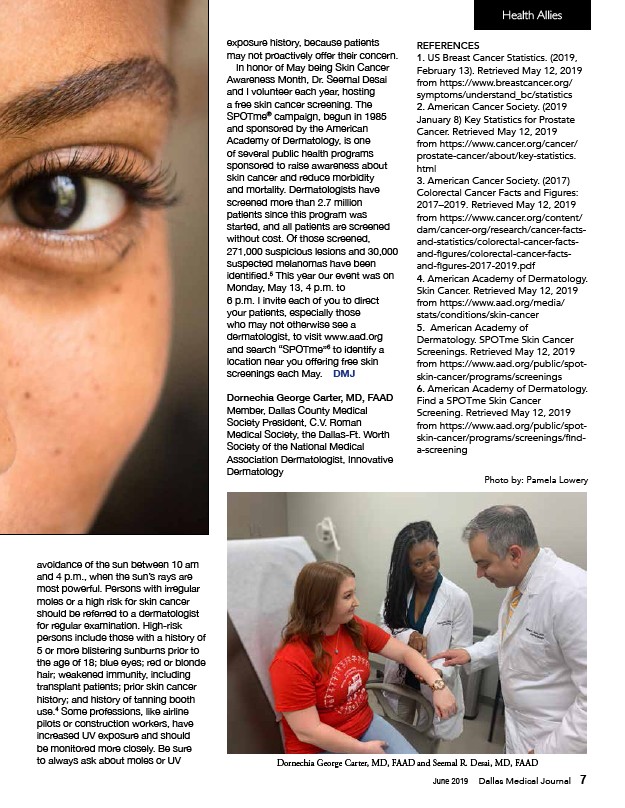
Health Allies
Photo by: Pamela Lowery
June 2019 Dallas Medical Journal 7
avoidance of the sun between 10 am
and 4 p.m., when the sun’s rays are
most powerful. Persons with irregular
moles or a high risk for skin cancer
should be referred to a dermatologist
for regular examination. High-risk
persons include those with a history of
5 or more blistering sunburns prior to
the age of 18; blue eyes; red or blonde
hair; weakened immunity, including
transplant patients; prior skin cancer
history; and history of tanning booth
use.4 Some professions, like airline
pilots or construction workers, have
increased UV exposure and should
be monitored more closely. Be sure
to always ask about moles or UV
REFERENCES
1. US Breast Cancer Statistics. (2019,
February 13). Retrieved May 12, 2019
from https://www.breastcancer.org/
symptoms/understand_bc/statistics
2. American Cancer Society. (2019
January 8) Key Statistics for Prostate
Cancer. Retrieved May 12, 2019
from https://www.cancer.org/cancer/
prostate-cancer/about/key-statistics.
html
3. American Cancer Society. (2017)
Colorectal Cancer Facts and Figures:
2017–2019. Retrieved May 12, 2019
from https://www.cancer.org/content/
dam/cancer-org/research/cancer-factsand
statistics/colorectal-cancer-factsand
figures/colorectal-cancer-factsand
figures-2017-2019.pdf
4. American Academy of Dermatology.
Skin Cancer. Retrieved May 12, 2019
from https://www.aad.org/media/
stats/conditions/skin-cancer
5. American Academy of
Dermatology. SPOTme Skin Cancer
Screenings. Retrieved May 12, 2019
from https://www.aad.org/public/spotskin
cancer/programs/screenings
6. American Academy of Dermatology.
Find a SPOTme Skin Cancer
Screening. Retrieved May 12, 2019
from https://www.aad.org/public/spotskin
cancer/programs/screenings/finda
screening
exposure history, because patients
may not proactively offer their concern.
In honor of May being Skin Cancer
Awareness Month, Dr. Seemal Desai
and I volunteer each year, hosting
a free skin cancer screening. The
SPOTme® campaign, begun in 1985
and sponsored by the American
Academy of Dermatology, is one
of several public health programs
sponsored to raise awareness about
skin cancer and reduce morbidity
and mortality. Dermatologists have
screened more than 2.7 million
patients since this program was
started, and all patients are screened
without cost. Of those screened,
271,000 suspicious lesions and 30,000
suspected melanomas have been
identified.5 This year our event was on
Monday, May 13, 4 p.m. to
6 p.m. I invite each of you to direct
your patients, especially those
who may not otherwise see a
dermatologist, to visit www.aad.org
and search “SPOTme”6 to identify a
location near you offering free skin
screenings each May. DMJ
Dornechia George Carter, MD, FAAD
Member, Dallas County Medical
Society President, C.V. Roman
Medical Society, the Dallas-Ft. Worth
Society of the National Medical
Association Dermatologist, Innovative
Dermatology
Dornechia George Carter, MD, FAAD and Seemal R. Desai, MD, FAAD